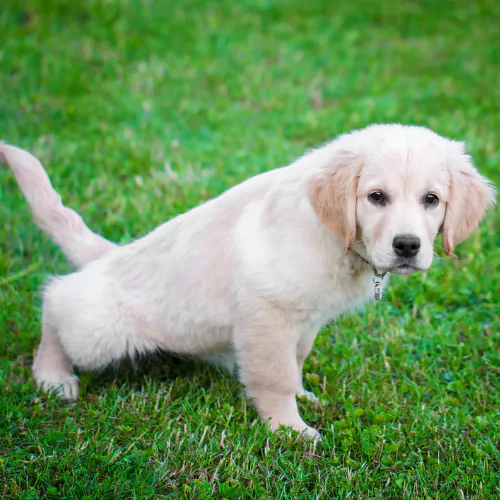
How to toilet train your puppy using positive reinforcement

Philippa Short
20 May 2022 | 10 minutes read
Toilet training your puppy might seem daunting, but don’t worry! Expert dog trainer Philippa Short is here to help make it a positive bonding experience for you and your pup. Let’s find out how to toilet train your puppy using Philippa’s positive reinforcement techniques.
- Steps to toilet training a puppy using positive reinforcement
> Step one of puppy toilet training – learn how to tell when your puppy needs to go toilet
> Step two of puppy toilet training – decide on your goal
> Step three of puppy toilet training – choose and condition your toilet cue words
> Step four of puppy toilet training – teach them how to ask to go out to the toilet - How to toilet train a puppy in a flat/with no garden
- How to toilet train a puppy at night
- How long does it take to toilet train a puppy?
> At what age should a puppy be toilet trained? - Why do puppies go backwards with toilet training?
- Other puppy toilet training questions
> How do you toilet train a puppy when you work all day?
> How long can a puppy hold it overnight?
> Why won’t my puppy go to the toilet outside of the house or garden?
Steps to toilet training a puppy using positive reinforcement
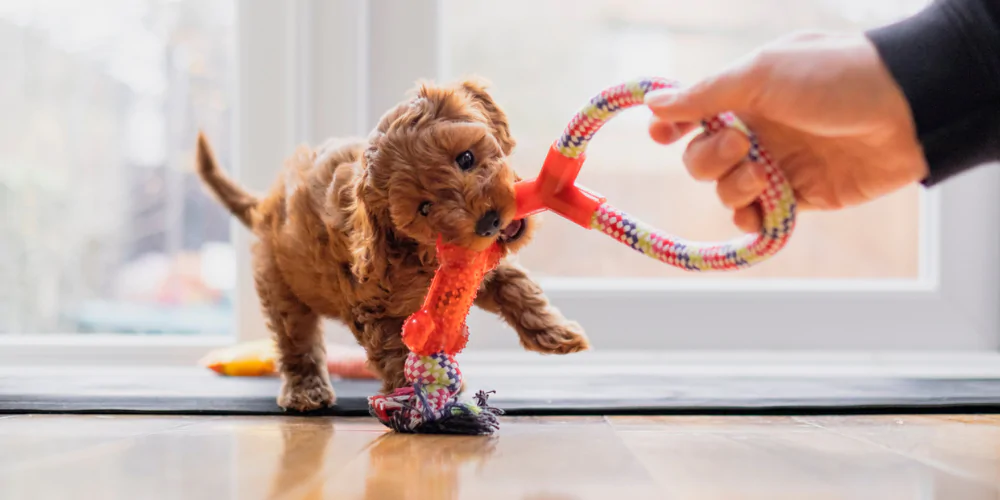
> Step one of puppy training – learn how to tell when your puppy needs to go toilet
First things first, how do you tell when your puppy needs to relieve themselves?
At eight weeks old, your puppy has a tiny bladder and doesn’t understand its signals. This means you’ll have no warning that they need to go.
So you’ll want to create a regular toileting routine where you carry them to your chosen toilet spot:
- Every half an hour
- As soon as they’ve woken up from a nap
- As soon as they’ve eaten or had a drink
- Immediately after a play session
As your puppy gets older, their bladder gets bigger and their muscles get stronger, giving them more control. At this point, you’ll have some telltale ‘I need to go’ signs like:
- Frantically sniffing or circling the ground
- Fidgety behaviour (seem conflicted and doesn’t know how to ask to go to the toilet)
- Going to another room or hiding behind an object (some dogs like to toilet in privacy)
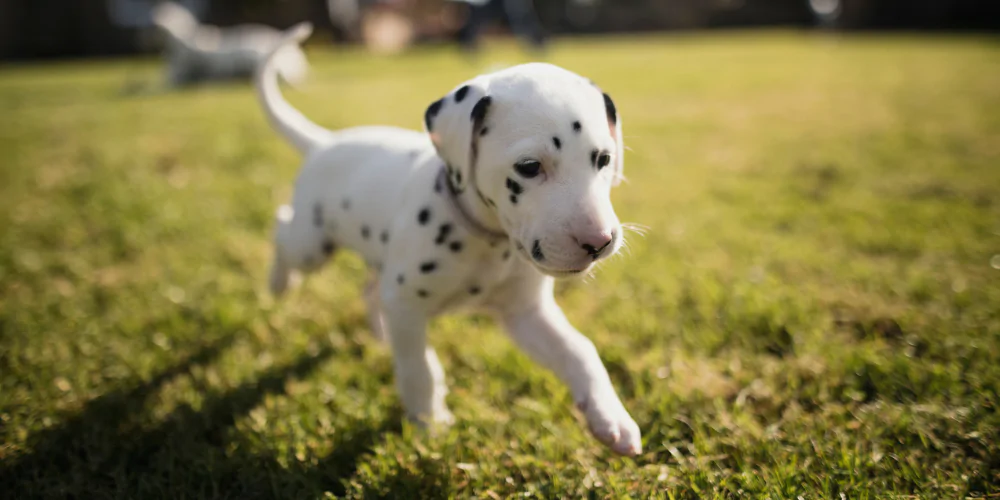
> Step two of puppy toilet training – decide on your goal
Before you start toilet training, decide on your goal. Remember we mentioned a ‘toilet area’ earlier? Where you want or need your pup to go to the toilet will depend on your individual needs.
For example, you may not have your own outdoor space, so your focus will be on indoor toilet training. Or you might have young children who play in the garden and want your pup to go to the toilet in a specific area.
This could be:
- A large litter tray (kept in the same place and away from their food and water bowls)
- A particular corner of the garden
- A dedicated outside toilet patch made of real turf, artificial grass, woodchip, or gravel
If you want your puppy to only use one specific toileting area, you need to teach this consistently to them. Letting them go in a different spot (even just once) can scupper this dedicated area.
So you’ll need to:
- Carry them to the area if they’re too small to hold their bladder
- Lead walk them to the area if they’re a bit older
It can take up to six months for them to form a strong habit of going to the same place, so patience is key. Eventually, they’ll start pulling you straight to their spot. This is when you can start trusting them to take themselves to the toilet.
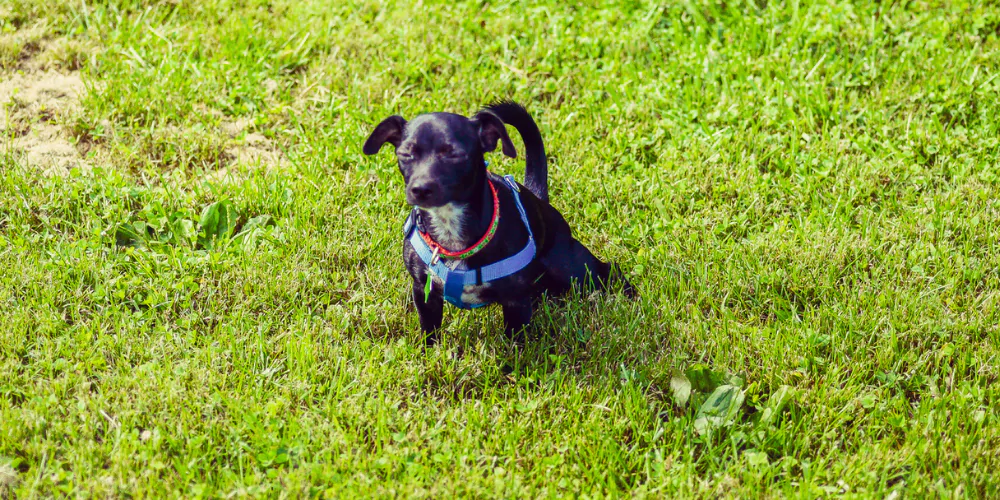
> Step three of puppy toilet training – choose and condition your toilet cue words
Once you’ve decided on your puppy’s toilet area, it’s time to choose and condition their toilet cue words.
- Pick a separate cue word for weeing and pooing – this makes it easier to prompt your pooch to do one or both
- Wait until the behaviour is happening, then quietly keep repeating the cue as they’re weeing or pooing
- Give lots of verbal praise as soon as they finish
- Spend at least a week repeating these steps for both cues
Notice we said verbal praise there, not treat? That’s because:
- Your puppy may become fixated on getting the treat and so may pretend to go – yep, even if they actually need the toilet
- You want your puppy to enjoy the feeling of relieving a full bladder and see that as the reward.
- Giving lots of praise is a bonus as it tells them you’re pleased with their behaviour.
Once you’ve done plenty of cue conditioning, you can start saying it slightly before the behaviour happens. This turns the cue into a prompt.
- Carry or lead walk them to the toilet area
- Wait until they’re readying themselves to do something, then say the cue
- Keep quietly repeating the cue as they’re weeing or pooing
- Give lots of verbal praise as soon as they finish
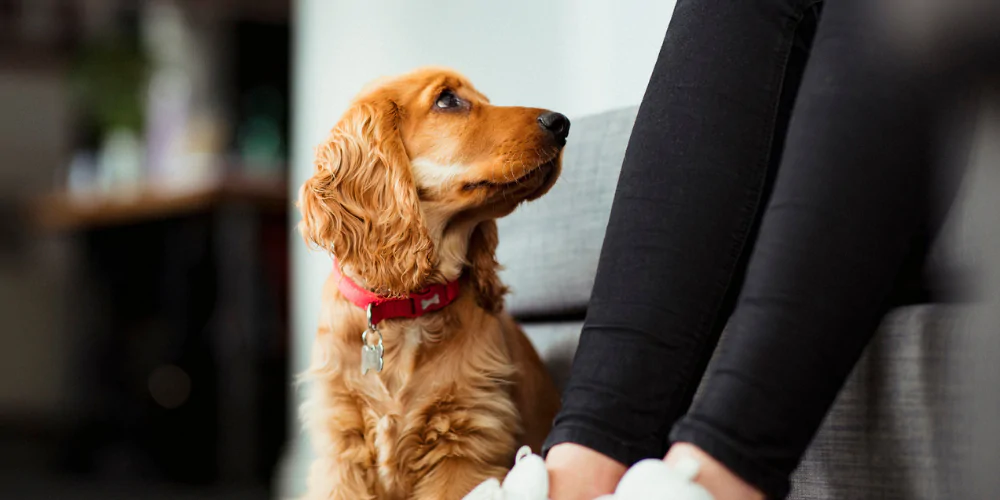
> Step four of puppy toilet training – teach them how to ask to go out to the toilet
Want your pup’s toilet area to be outside? This step is for you – teaching them how to let you know when they need to be let out.
One option is to hang a bell from the door handle and teach them to tap or nudge it with their paw. This is immediately rewarded with a treat and the door being opened.
The upside is your puppy learns that moving the bell gets the door open. It’s also very straightforward to teach. But the downside? Your puppy could think that the purpose of the bell is to get a treat
So instead of using a bell, try teaching your pup the ‘shall we go toilet’ cue.
- Say the cue and then pick them up or lead them to the toilet area
- Keep eye contact with them when you say the cue
- Your pup will start to learn that if they want the door open, they need your attention
- As they start to come up to you, wait for the eye contact and say the cue, then take them out
- Watch out for demand barking – you want eye contact, not barking as a response to the cue
- Don’t leave the back door open – you want them to learn they need you to open it for them
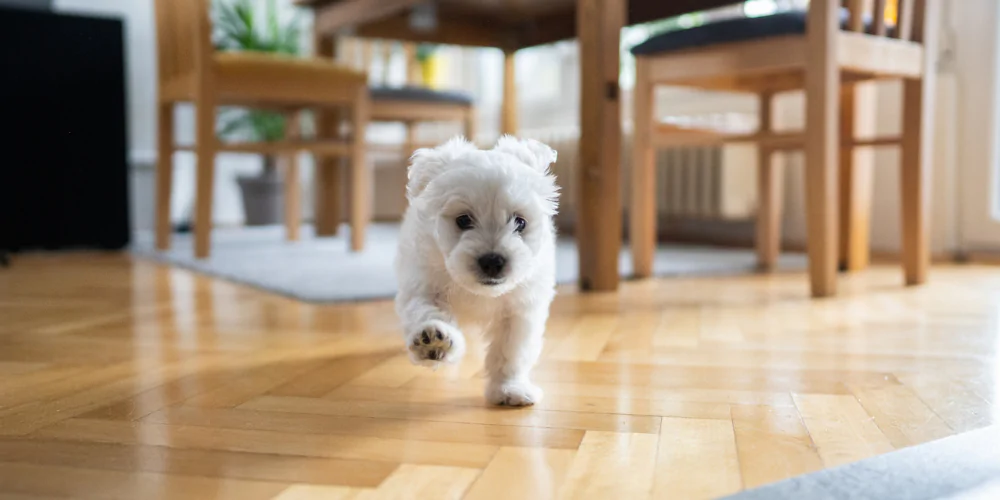
How to toilet train a puppy in a flat/with no garden
How do you handle puppy toilet training if you live in a flat or don’t have a garden? Or perhaps you have a disability that stops you from getting to the door quickly?
You can toilet train your puppy indoors using a litter tray:
- Get a large tray to suit the size of your dog with a two-inch depth so they have to climb in – a plasterer’s tray could work
- Put in your lining of choice, such as wooden pellets, puppy pads, fake grass or real turf
- Keep in mind your choice – your pup may try to chew types of lining, while others have higher upkeep (such as needing to regularly replace real grass)
- Find a place for the tray and stick to it, keeping it away from their bed and eating areas
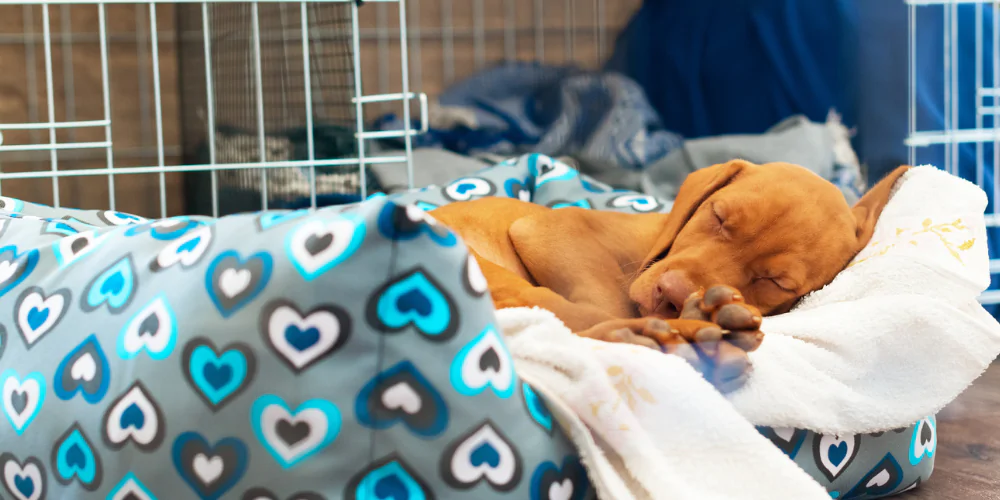
How to toilet train a puppy at night
Young puppies won’t be able to hold their bladder from bedtime until morning. To toilet train a puppy during the night:
- Keep regular bedtime and wake up hours to set up a routine for your pup.
- Go to their sleeping area, making sure not to talk to them (so they’re not stimulated). Pick them up and take them out, giving them quiet praise when they go toilet.
- Pick them back up and put them straight back in their bed
For the first few weeks, you may need to take them to the toilet every two to three hours. As time goes on, you’ll notice they’re still asleep when you go to them and will only go for a small wee. This is when you can start stretching out the time between their nightly toileting.
If you don’t want to get up at night, your puppy will need somewhere to go toilet. This means putting down puppy pads or a litter tray, else they’ll have an accident.
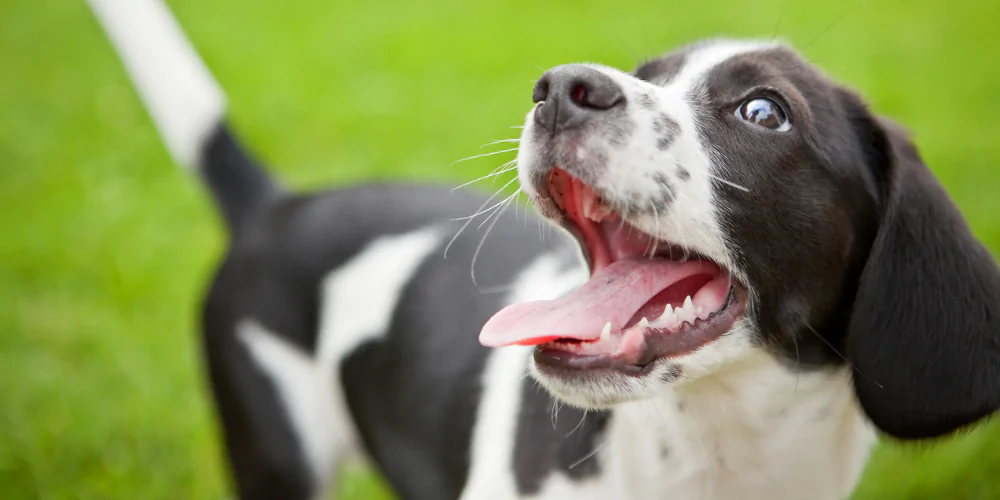
How long does it take to toilet train a puppy?
How long it takes to toilet train depends on different things:
- Training consistency
- Using the same cues to reinforce them
- History of the breeder (if they started concept toilet training)
- Breed (some take longer than others, or are never fully toilet trained)
Expecting your puppy to be toilet trained in five or seven days is unrealistic and puts unwanted stress and pressure on them.
> At what age should a puppy be toilet trained?
Many puppies are toilet-trained from four months onwards but this does vary based on their training and breed.
Being fully toilet trained doesn’t mean your puppy can just hold their bladder overnight. You should also be confident that they can be trusted to:
- Hold their bladder during the day
- Wait to go toilet
- Ask you to let them out when they need to go
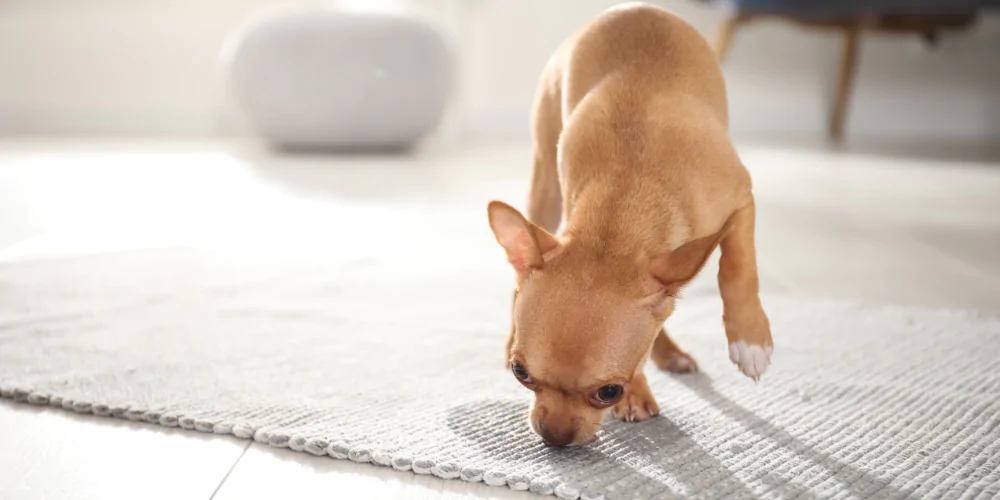
Why do puppies go backwards with toilet training?
Sometimes, your toilet-trained puppy might start to have accidents again in the house. There’s a couple of reasons why this might happen:
- Your female dog is heading towards her first season. She doesn’t have as much control over her reproductive parts so it can look a bit like leaking.
- Your male dog is reaching puberty. He has four times as much testosterone and this means he’ll get very excited by the scent of other dogs. He may cock his leg to mark his territory, to announce himself to all the ladies that may be around, and tell the boys that he is a contender for the girls.
Your pup may also have lost bladder control because of a medical problem. Urinary tract infections (UTIs) are very common in puppies, so always speak to your vet if you think your puppy isn’t well. Petsure customers have 24/7 access to video appointments with a FirstVet vet.
Signs that your older pup might have a medical problem include:
- Wetting themselves when they’re sound asleep
- Wee that has discharge, a pungent smell, or a rusty red colour
- Walking around and weeing (either dripping or streaming)
- Excessively drinking
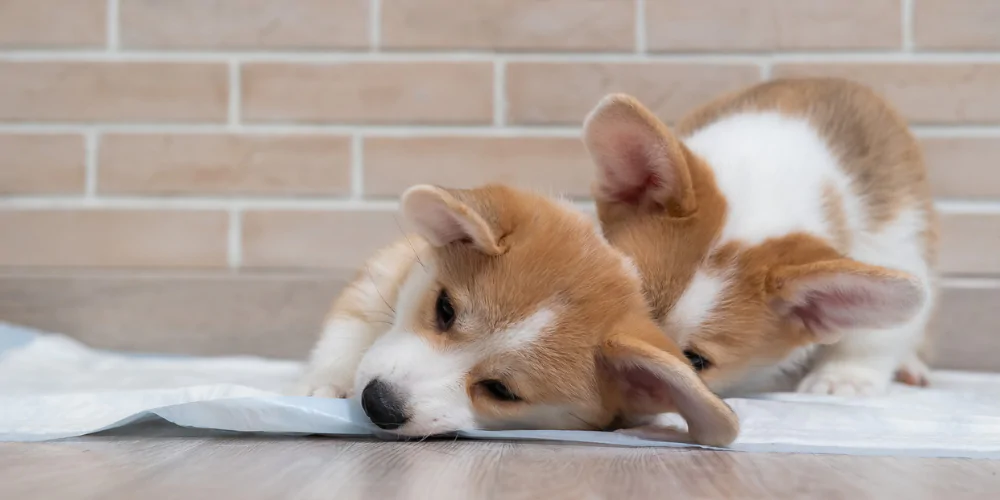
Other puppy toilet training questions
> How do you toilet train a puppy when you work all day?
Being a responsible puppy parent means making sure you’re there for them, especially during the first few weeks. Remember, they’re in a new home and away from their siblings. They need you there to help them settle in and begin some basic training.
This could mean taking some time off work to set up their routine and start their toilet training. If you’re not at home, you’ll need someone who can look after your dog or come over every hour.
> How long can a puppy hold it overnight?
As we mentioned earlier, eight-week old puppies can only hold their wee for a couple of hours at night time. As they grow and their bladders get bigger and stronger, they can hold their wee in for longer before needing to go out.
> Why won’t my puppy go to the toilet outside of the house or garden?
When puppies are very young, they will try and hold in their scent as much as possible. They feel vulnerable and don’t want to announce their arrival to the outside world.
So it’s perfectly normal if your puppy takes a while to want to toilet in new places, even if they’re comfortable doing it at home. The more anxious or worried personality types will take longer to go toilet outside the home.
Protect your pup during their early years and through to adulthood with Petsure pet insurance for puppies.


